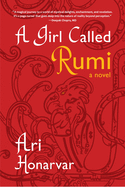
Journalist/artist/activist Ari Honarvar's promising debut, A Girl Called Rumi, memorializes the lifesaving power of storytelling through the darkest terrors. In 1981, the Iran-Iraq War was still new and a semblance of normalcy seemed possible for nine-year-old Kimia, who claims "Rumi" as parttime moniker. She's missing her father who's away working. Her mother, Roya, should be kinder; so could her older brother, Arman. Maybe best friend Reza is all she needs. But restrictions are growing. The itchy hijab is mandatory. Arman's joined a militant youth group. Roya's punishments are turning vicious. Yet somehow, Kimia and Reza find temporary sanctuary through a hidden trap door where a mysterious storyteller and his loquacious myna bird await.
In 2009, Kimia is living in San Diego where she's now a spiritual counselor, or so her clients call her. She's divorced, untethered, finds relief from her inner turmoil by regularly cutting herself with an antique dagger. Arman is a new club manager after multiple abandoned careers. And suddenly, Roya announces she's ready to return home to Shiraz--to die. The family's homegoing becomes a dangerous journey of labyrinthine secrets.
Honarvar reveals in her afterword how details of her own emigration from Iran became imbedded in her fiction. Her multiple narrators here create a mosaic of Iran's brutal history; their survival becomes bearable through sharing ancient myths, legends, poetry. Persian cultural icon Rumi--as lasting legacy, guide, comfort--especially inspires Honarvar's characters throughout. Honarvar's escape might be decades past, but a life on the run remains all too familiar to many: "This book is a love letter to all the displaced souls who yearn to become their own alchemists." --Terry Hong, Smithsonian BookDragon

